
Mathematical ImageryMathematical artists create strong, stunning works in all media and explore the visualization of mathematics
2013 Mathematical Art Exhibition
The 2013 Mathematical Art Exhibition was held at the Joint Mathematical Meetings held in San Diego, CA. Here on Mathematical Imagery is a selection of the works in various media. Mathematical Art Exhibition Awards were given: "Bended Circle Limit III," by Vladimir Bulatov was awarded Best photograph, painting, or print; "Inlaid Wooden Boxes of Makoto Nakamura's Tessellations," by Kevin Lee was awarded Best textile, sculpture, or other medium; and "Tessellation Evolution," a beaded necklace by Susan Goldstine received Honorable Mention. The Award "for aesthetically pleasing works that combine mathematics and art" was established in 2008 through an endowment provided to the American Mathematical Society by an anonymous donor who wishes to acknowledge those whose works demonstrate the beauty and elegance of mathematics expressed in a visual art form.
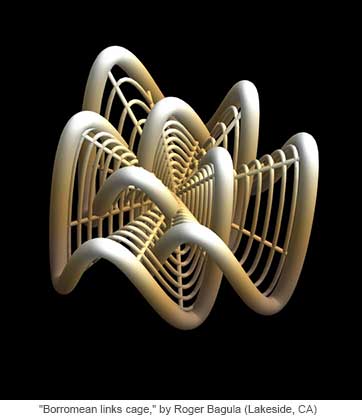
3.4" x 3.2" x 0.9", White plastic, 2012. The art work is made using Mathematica and 3d models that can be printed are obtained for most of the work. Since I was a boy I have drawn jet air planes and I have made a number of 3d models what I imagined. I have been studying ruled surfaces determined by torus knots and Möbius connecting surfaces. Here three links in a Borromean configuration are bridged by a cage surface. The bridge surface is not a Seifert surface, but a simple set of ruled Bezier surfaces. --- Roger Bagula
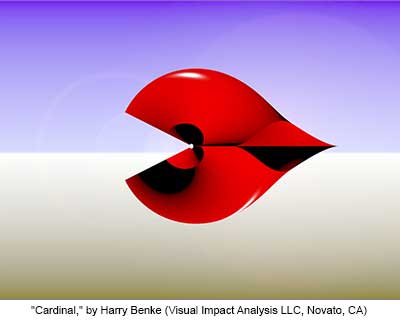
20" x 26.6", Giclee (pigmented archival print), 2012. I'm an artist and mathematician. My art attempts to produce a nexus between abstract mathematical beauty and the natural world to produce a satisfying aesthetic experience. I've been examining Kuen's surface for a very long time. The red shape is Kuen's surface as seen from above, looking down the z axis. Kuen's surface is well known since it has constant negative Gaussian curvature except on sets of measure 0. This surface is virtually never seen from above, which is intriguing and beautiful. -- Harry Benke (1949-2014) For information on original works by Harry Benke please contact julianne at visualimpactanalysis dot com.

30" x 25", Photographic print of 3D model, 2011. My mathematical art forms several large series exploring the creation of complex forms through sequences of simple operations or representations of simple relationships. The operations include geometric transformations, neighbor finding, attraction/repulsion and others. These computational processes attempt to replicate features of both geologic and organic morphogenesis. This image was created by application of a sequence of 3D geometric transformations to a collection of spheres on the faces of a hollow cube. The exact sequence to produce this image was obtained through the use of a genetic algorithm using subjective aesthetic appeal as the fitness function. -- Leo Bleicher
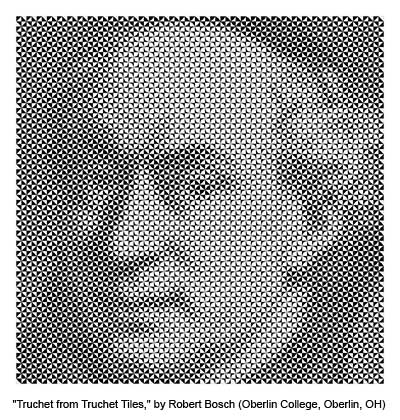
18" x 18", Digital print on canvas, 2012. Father Sébastien Truchet (1657-1729) was a Carmelite clergyman. He was King Louis XIV's favorite hydraulic engineer. He designed fonts. And in 1704 he published an article, "Mémoire sur les combinaisons," that described his mathematical and artistic investigations into how a simple set of square tiles, each divided by a diagonal into a white half and a black half, can be arranged to form an infinity of pleasing patterns. Today, Truchet's tiles are known as, well, Truchet tiles. To create a Truchet-tile portrait of Truchet, I started with the orientations specified by Pattern D of Plate 1 of Truchet's article. I then allowed the diagonals of the tiles to "flex" or bend at their midpoints. To make a tile darker, I would flex the diagonal into the black half. To make a tile brighter, I would flex the diagonal into the white half. With my Flexible Truchet Tiles, I can approximate any grayscale image, using the image to "warp" any initial pattern of Truchet tiles. -- Robert Bosch

Best photograph, painting, or print - 2013 Mathematical Art Exhibition
24" x 24", Digital print, 2012. M.C. Escher's hyperbolic tessellations Circle Limit III is based on a tiling of the hyperbolic plane by identical triangles. The tiling is rigid because hyperbolic triangles are unambiguously defined by their vertex angles. However, if we reduce the symmetry of the tiling by joining several triangles into a single polygonal tile, such tiling can be deformed. Hyperbolic geometry allows a type of deformation of tiling called bending. Let's extend the tiling of the hyperbolic plane by identical polygons into tiling of hyperbolic space by identical infinite prisms. The prism's cross section is the original polygon. The shape of these 3D prisms can be carefully changed by rotating some of its sides in space and preserving all dihedral angles. Such operation is only possible in hyperbolic geometry. The resulting tiling of 3D hyperbolic space creates 2D tiling on the infinity of hyperbolic 3D space, which is a Riemann sphere. The sphere is stereographically projected to the plane. -- Vladimir Bulatov
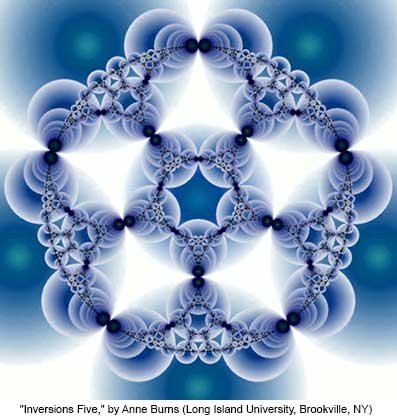
12" x 12", Digital Print, 2012. Five pairwise tangent circles are all tangent to a sixth circle centered at the origin. The discs bounded by these six circles are colored in blue-green. An iterated function system is made up of repeated inversions in the six circles. -- Anne Burns
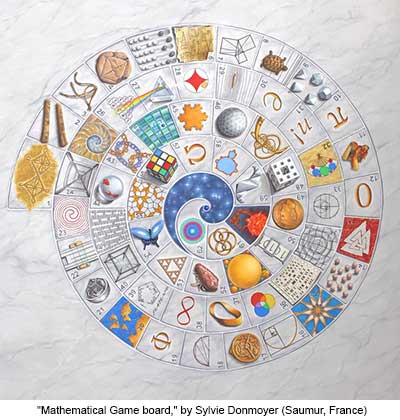
28" x 28", Oil paint on canvas, 2012. The design of the game board is suggested by the Archimedean spiral, divided in 62 spaces. It is played by two or more competitors and two dice. In the spaces are images relating to the History of Mathematics, in chronological order. As usual in this type of game, some spaces will bring you forward and others back, while the winner is the first to reach the stars. -- Sylvie Donmoyer
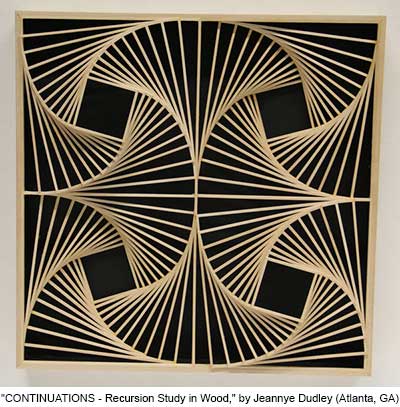
18" x 18" x 4", Basswood, 2012. The visual continuous curves were generated parametrically by a recursive design pattern developed based on simple a square motif and a replication rule (ratio) of 1 to 9. At first glance the piece appears flat; this effect is achieved through the black background. All the visual clues that the eye searches for to determine depth are lost in the dark monolithic background. The success in this piece is that it encourages the observer to wonder where does the pattern begin and end. The pattern becomes a path of CONTINUATIONS by providing an overlap at the initial four squares. This recursive design pattern provides the starting point for many other architectural investigations, like a stair case, a roof canopy or a wall panel system. The excitement is - integration of math - art - architecture. -- Jeannye Dudley

18" x 18" x 18", Color printed cardboard, 2012. The goal of my art is to create aesthetically pleasing repeating patterns related to hyperbolic geometry. This is a pattern of fish (inspired by M.C. Escher's Circle Limit III) on the regular triply periodic polyhedron composed of equilateral triangles meeting 8 at each vertex, which can be denoted by the Schläfli symbol {3,8}. It is formed from octahedral hubs which have octahedral struts connecting the hubs; the struts are on alternate faces of the hubs. This polyhedron approximates Schwarz' D-Surface which is the boundary between two congruent, complementary solids, both in the shape of a "thickened" diamond lattice (the hubs are the carbon atoms and the struts are the atomic bonds). There are fish of four colors. The blue fish all swim around the "waists" of the struts. The yellow, green, and red fish swim along lines that approximate the set of Euclidean lines that are embedded in Schwarz' D-Surface. In the image, the yellow fish swim right to left, the green fish swim from lower left to upper right, and the red fish swim from upper left to lower right. -- Doug Dunham
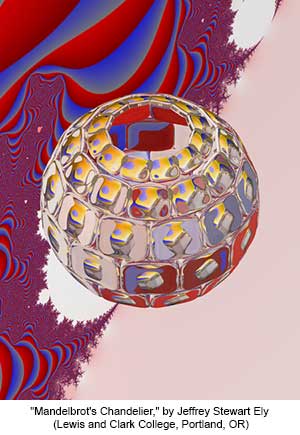
24" x 18", Digital print on archival paper, 2012. The spherical chandelier is composed of squarish lenses. Inside the chandelier is a cubical object that has been painted with the Mandelbrot set. Each of the lenses gives us a different view of this object. This interior object and the individual lenses are all variations of the quartic surface, $x^4 + y^4 + z^4 = 1$. The image was constructed using the ray tracing technique and required the solution of over a billion quartic equations, $At^4 + Bt^3 + Ct^2 + Dt + E = 0$, as the individual rays through each pixel were followed into this mathematical world of quartic surfaces. Snell's law was used to correctly model the refraction of the rays as they passed through the lenses. Finally, the background also shows a portion of the Mandelbrot set. -- Jeffrey Stewart Ely
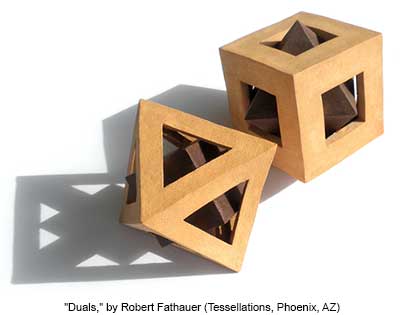
12" x 6" x 6", Ceramics, 2012. The cube and octahedron are duals of each other. In these two pieces, an octahedral frame encloses a cube and a cubic frame encloses an octahedron. The contrasting colors in the frames and enclosed polyhedra are due to the fact that they are made from two different types of clay. Neither was glazed, so the natural appearance of the fired clays is seen. -- Robert Fathauer

Honorable Mention - 2013 Mathematical Art Exhibition
18" x 15", Glass beads, gold-plated glass beads, onyx beads, gold-plated clasp, thread, 2012. From one end of this necklace to the other, the design evolves through 16 different tessellations of the cylinder by congruent tiles in four colors. The strips of beads along the top and bottom of the frame, woven out of larger beads for clarity, exhibit the 16 tiles underlying the bead tessellations. The body of the necklace is a bead crochet rope. To construct the design, I manually colored a planar hexagonal grid of beads using the symmetry constraints imposed by crocheting the beads into a spiral. To make the necklace, I strung 4307 beads in the order dictated by the design onto five spools of thread, then crocheted the bead rope using a 1.1 mm hook. The caps at the end of the tube are woven with an additional 210 beads. -- Susan Goldstine
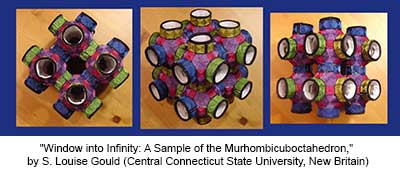
6.5" x 6.5" x 6.5", Embroidery on cotton fabric, 2012. This is an extension of the work I have done with fabric polyhedra. "The Symmetries of Things" written by Conway, Burgiel and Goodman-Strauss has provided many pathways to explore and it was the inspiration for this piece. This Archimedean infinite polyhedra is constructed of regular hexagons and squares. It illustrates the symmetry *642. Each vertex has 4 squares and one hexagon surrounding it. This model uses squares of four colors to show how the model moves into space. Each of the modules is constructed from a "net" of embroidered squares and hexagons. The nets were designed on Geometer's Sketchpad then digitized using 4-D Professional Software and stitched on a Viking Topaz embroidery sewing machine. The pictures show the object from three different directions. -- S. Louise Gould
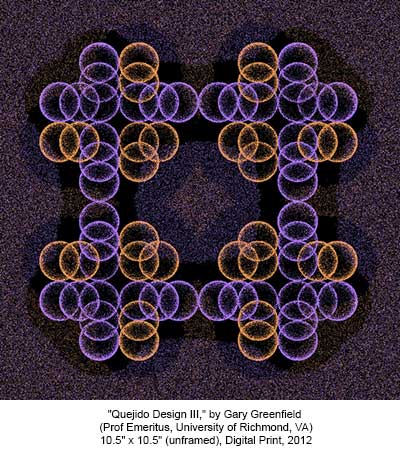
10.5" x 10.5" (unframed), Digital Print, 2012. Between 1968-1972 Spanish artist Manuelo Quejido collaborated with computer programmers at the University of Madrid in order to execute a series of state-of-the-art computer generated "sequence" designs consisting of patterns of disks. As an homage, Quejido Design III realizes one of these patterns using state-of-the-art agent based methods. Here, agents are virtual ants modeled after the species T. albipennis that collect dispersed grains of sand in order to form circular nest walls. By using two different colors for sand grains and by assigning to each virtual ant a center, radius, and color, a uniform density grid of sand grains self-organizes into a pattern which, up close, has no color symmetry, but from a distance is perceived of as being color preserving under various symmetry operations. -- Gary Greenfield
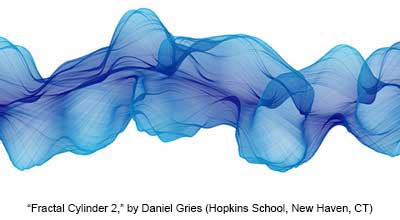
11.5" x 22", Giclee print from JavaScript-generated digital image, 2012. In Fractal Cylinder 2, curves are drawn along waist curves, colored by a radial gradient. Low alpha values create differing densities and transparency. -- Daniel Gries
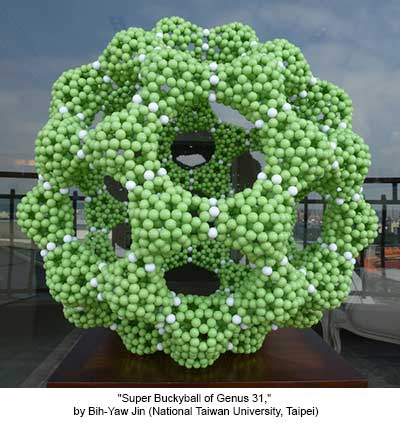
20" x 20" x 20", Plastic beads, 2011. Joining with students and teachers of the Taipei First Girls High School in November 2011, we made two bead models of super buckyball, a polyhedron of genus 31. Each vertex in this model is itself a buckyball punched with three holes and then connects to three neighbored vertices by three shortest carbon nanotubes. We can also view structure as the second level Sierpinski buckyball, which can be extended arbitrarily to infinity. -- Bih-Yaw Jin
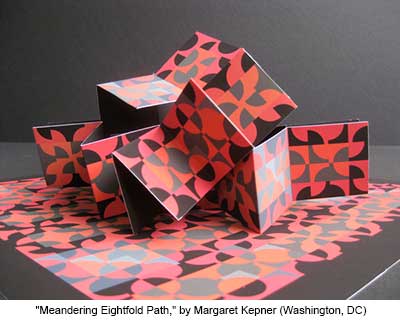
Flat: 18" x 18"; Folded: 3" x 6" x 0.5", Archival Inkjet on Paper, 2012. This work is a modified version of an earlier design--The Eightfold Path. Colors have been added, and the flat 2D print has been deconstructed into a folding book format. The underlying design is a visual presentation of the five non-isomorphic groups of order eight: C8, C2 x C4, C2 x C2 x C2, D4, and Q8. It employs a visual vocabulary derived from a traditional quilt pattern, Drunkard's Path. Each of the small shapes used in the design is a quarter circle in a square, scaled so that its area equals the square's residual area. The 36-page book structure is created from a single sheet of paper through a series of cuts and folds. A continuous meander folding path is followed, with varying length fold-sequences, and no beginning nor end. When it is fully folded up, the book assumes a double-square footprint. A smaller-scale meander path, which would result in a continuous 144-page book, is expressed through color accents. -- Margaret Kepner
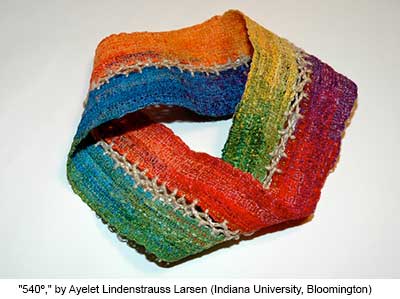
1" x 8" x 8", Cotton, silk, dissolvable muslin, 2003. This Möbius band is twisted three times, each time by 180 degrees, before its short sides are attached to each other. Topologically, it is the same as the usual Möbius band where the band is twisted only once before attaching the short sides to each other; it is just embedded in 3-space in a different way. The edge of a Möbius band consists of one long circle. If you follow the edge of this Möbius band, you will go through the colors of the rainbow, from red to purple, and then transition to red through red-purple and begin the cycle again. -- Ayelet Lindenstrauss Larsen

Best textile, sculpture, or other medium - 2013 Mathematical Art Exhibition
4" x 4" x 4", Wood: Cherry, Maple, Walnut, Oak, Butternut, Mahogany, 2012. Makoto Nakamura has created a collection of tessellation designs that rival M. C. Escher's collection. The six designs on this box represent the asymmetric, isohedral Heesch tile types: TCCTC, TG1G2TG2G1, TCCTGG, C3C3C3C3C3C3, and CC4C4C4C4. -- Kevin Lee
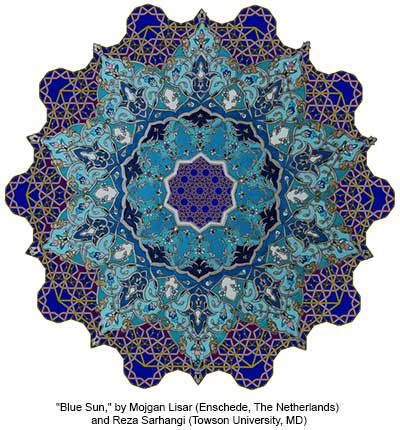
16" x 16", combination of hand painting and computer work, 2012. The Blue Sun is a collage of two different Persian works of art, both with deep mathematical roots: Tiling and Tazhib. The mosaic design on the back is a two-level self-similar tiling that has been made based on the decagram. This structure possesses a 10-fold rotational symmetry. This symmetry can be expanded in all directions using the five Sâ:zeh motifs introduced in "Polyhedral Modularity in a Special Class of Decagram Based Interlocking Star Polygons" by Reza Sarhangi, the 2012 Bridges Proceedings. The tiling at the center presents the tiling of a decagram that follows the same rules as the larger tiling in the back. The front image is a decagram Tazhip. In a traditional Persian Tazhib, one can find mathematical ideas and concepts, such as symmetries, spirals, polygons and star polygons. -- Mojgan Lisar and Reza Sarhangi (1952-2016)
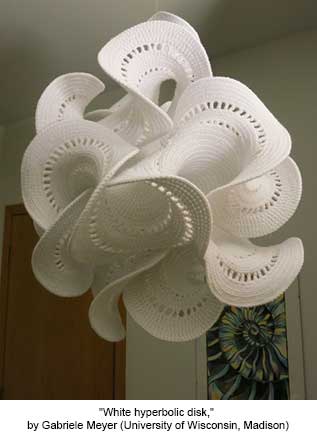
20" x 17" x 17", Polyester yarn and shaped line, 2012. This started out as a white disk crocheted in a spiral fashion. By making more than the necessary stitches, it takes on this characteristic wavy form. The hyperbolic disk is the most basic form of a hyperbolic surface, other possible shapes include blossoms and algae. I particularly like the play of light and shadow on this hyperbolic surface. That's the reason why I made this one just pure white. The holes created by double and triple stitches allow further light and shadow play. -- Gabriele Meyer
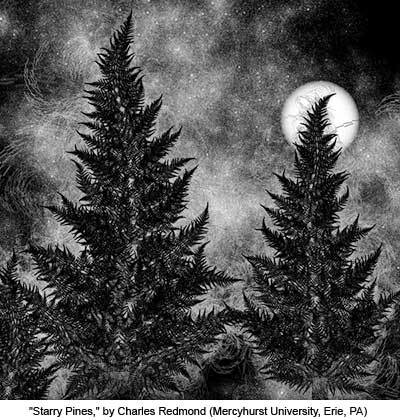
16" X 16", Generated by code written in the Context Free Art language, no photo-editing software used, 2011. Every program written in the Context Free Art language may be considered to be a context free grammar for creating images. Thus, when one programs in this language, one is "inventing" grammars. Any image produced with such a grammar may be considered to be a legal sentence in the grammar. If randomness is introduced into the program, then there are many different legal sentences or images, and one is producing generative art. When I created Starry Pines, I was studying tree creation with Context Free Art while at the same time experimenting with a technique of mine for creating star clusters and galaxies. I put them together for this work, along with a recursive icy swirl added to the rules for the trees. -- Charles Redmond
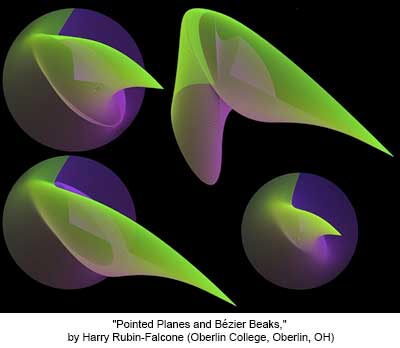
15.5" x 20", Digital Print, 2012. Each figure is created with a series of Bézier curves. Because there is space between each curve, you can see some parts of the curves behind the others, which gives each figure a translucent and three dimensional look. The curves can be thought of as lying on a plane, which means each figure is a representation of a folded-over plane that comes to a point. -- Harry Rubin-Falcone

Four pieces: 111mm x 111mm x 105mm, 125mm x 130mm x 99mm, 125mm x 125mm x 118mm, 103mm x 103mm x103mm, PA 2200 Plastic, Selective-Laser-Sintered, 2012. As elegantly discussed in Ghys' 2006 ICM plenary talk, the natural parameterization of the Seifert surface for the trefoil knot uses Eisenstein series of lattices in the plane. This was generalized by Milnor to all $(p,q)$ torus knots; he replaces Eisenstein series by certain fractional automorphic forms. Tsanov reduces the construction of these forms to finding an analytic description of the universal covering of the orbifold $S^2(p,q,\infty)$ by the hyperbolic plane. Mainly following Lehner, we find a Fourier series for the covering map. Combining these ideas, we obtain a map from a hyperbolic triangle $T_H$, with angles $\pi/p, \pi/q$, and $0$, to a domain $T_S$ in $S^3$; rigid symmetries of $T_S$ in $S^3$ generate the Seifert surface. Using Schwarz-Christoffel theory we uniformize $T_H$ by a Euclidean triangle $T_E$ having angles $\pi/p, \pi/q$ and $\pi(1-1/p-1/q)$. In this way we transfer decorations on $T_E$ to the Seifert surface; for these sculptures we use a subdivision of $T_E$ into 15 congruent triangles. -- Saul Schleimer and Henry Segerman
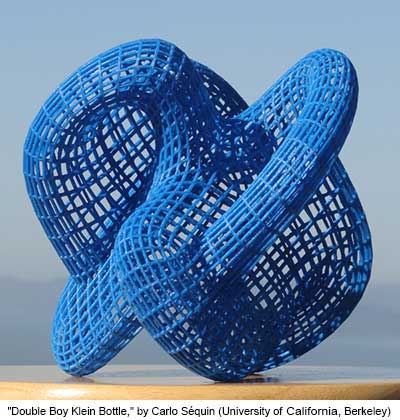
6" x 8" x 7", FDM Model (blue ABS plastic), 2012. Boy's surface, a compact model of the projective plane, with a small disk removed is topologically equivalent to a Möbius band. Every Klein bottle can be composed of two Möbius bands that are glued together by their edges. In this model a Klein bottle is created by gluing together two mirror images of a 3-fold symmetrical Boy surface with a disk removed from its pole. The result is a Klein bottle with S6 symmetry, showing six of the "inverted sock" openings characteristic of the classical Klein bottle. -- Carlo Séquin
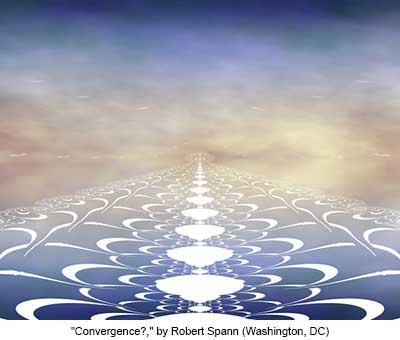
11" x 14" including frame, Digital Print, 2012. Computer graphics allows one to see both the numerical and aesthetic properties of dynamical systems. Recently I became interested in the properties of complex functions in which a complex variable is raised to a complex, rather than an integer exponent. I have also been analyzing complex polynomials that have no attracting fixed points. This image is produced by applying Newton's method for root finding to the complex function (z^(2+3i)-.09)*(z^(2-3i) -.09). The white areas are points in the complex plane where this function does not converge to any root. The background is produced using Perlin noise functions. -- Robert Spann

6" x 6"x 6" closed, 6" x 6"x 18" opened, Clear acrylic, 1970. My work is directed at demonstrating the amazing interrelationship of the Regular Polyhedrons (Platonic Solids plus Kepler/Poinsot), and the Golden Ratio (1.618). Blending these together creates the three dimensional projection of the Fibonacci numbers. I call this phenomenon the Morphohedron. Transparent Dodecahedron that open to reveal clear cube inside that opens to allow a tetrahedron/octahedron to come out, which opens to reveal the inner icosahedron. All the Regular Solids (Platonic Solids) are here harmoniously nested. -- Stephen Wilmoth



